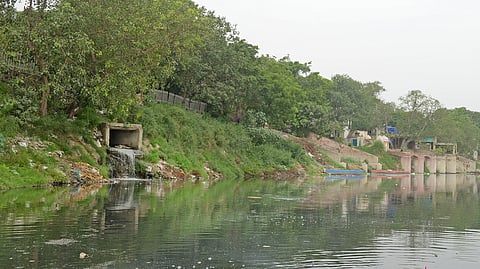From pale to black: Colour says it all
NEW DELHI: On a serene morning at the banks of the Yamuna near Jagatpur, people can be seen enjoying time with their families. The air is filled with laughter and the gentle murmur of flowing water.
Several visit the area to perform rituals, while others stroll along the banks to soak in the calm. Children with bare feet wade into the shallow water, holding their parents’ hands and splashing water at each other.
However, the condition of the river further downstream near Kashmere Gate is far from pleasant. The water begins to stink and turns darker — almost black. Here, the Yamuna bears the burden of neglect and growing pollution. People can be seen throwing polythene bags filled with various items into the river from bridges and railway tracks.
Manoj Singh, a resident of nearby Yamuna Ghat, said they try their best to maintain cleanliness. “We try to keep the river clean. However, the main responsibility lies with the government. We depend on this river for many things. The government must act — not tomorrow, but today,” Singh said.
A local boatman echoed similar concerns, saying their livelihoods have been impacted by the polluted water. “I have worked as a boat rider here for the last eight years. Earlier, the water was somewhat clean, but now it has turned black and smells awful. Yamuna is not just a river for us — it’s our livelihood and identity. The boating business has declined due to the river’s condition. Earlier, people used to come here to ride boats, pray and enjoy the banks. Boatmen are struggling. We do not seek luxury; we only want a clean river,” he said.
He added that during winter, visitors come to watch Siberian birds that migrate to this area, but the river’s poor state is discouraging for both wildlife and tourists.
Meanwhile, experts warn against the prevailing perception that Yamuna remains clean upstream of the Wazirabad barrage and get polluted only afterward. Bhim Singh Rawat, Associate Coordinator at the South Asia Network on Dams, Rivers and People (SANDRP), called this belief “illusionary.”
“In reality, the government’s own water quality reports and incidents of Delhi’s water treatment plants getting disrupted due to increased pollution indicate that the river’s health has deteriorated even upstream of the barrage over recent years,” he said. Rawat further explained that the discharge of industrial and domestic effluents from Haryana’s Sonipat, Panipat, Karnal, and Yamuna Nagar districts into the river via Drain Numbers 8, 2 and Dhanaura Escape is accelerating the degradation.
“The idea that Yamuna’s problems begin only in Delhi is misleading. The continued degradation in the city is the end result of unchecked destructive activities upstream — including dam construction in the Himalayas and diversion of river flows for irrigation, drinking, and industrial use in the plains,” Rawat said. He stressed that all basin states are equally responsible for exploiting the Yamuna’s water, minerals, and ecological resources.
“Rampant and unsustainable sand mining in Haryana and Uttar Pradesh has disrupted the river’s essential lean season flow. This reduced flow means the river no longer has the capacity to dilute pollution once it enters Delhi,” he added. Rawat also criticised the new government in Delhi for following the same “failed model” of cleaning the river, rather than focusing on reviving it.
“The increasing pollution in Delhi, including the frothing problem at the Okhla barrage this year, highlights the collective failure of pollution control boards in Haryana, Delhi, the Central Pollution Control Board (CPCB), and the National Mission for Clean Ganga (NMCG),” he said.
He stressed that Delhi alone cannot revive the Yamuna and called for the central government to implement a holistic river revival plan. “There must be a united effort with Yamuna basin states to restore environmental flows. Pollution control systems must be made effective and accountable. Otherwise, the river faces a bleak future,” Rawat warned.
Amid the growing crisis, the Delhi government has allocated Rs 500 crore in the 2025–26 budget for repairs and modernisation of sewage treatment plants (STPs). The Najafgarh drain — one of the largest sources of pollution in the Yamuna — will undergo a significant transformation, with Rs 200 crore set aside for its conversion and interception.
Water Minister Parvesh Verma had earlier ordered a third-party audit of all 37 STPs in the capital to assess their actual performance and capacity. The directive came after a review meeting with the Delhi Jal Board’s sewage management team, where Verma was updated on the ongoing rehabilitation and upgrade projects.
Of the 37 STPs, 18 are currently being upgraded to improve their efficiency. In addition, 3 new STPs are under development at Sonia Vihar, Delhi Gate, and Okhla. These new facilities are expected to increase treatment capacity by an estimated 47 million gallons per day. Despite these efforts, untreated sewage continues to enter the Yamuna, prompting calls for stricter oversight.
“A substantial amount of untreated sewage is still flowing into the river. The government is committed to reducing this pollution load through comprehensive interventions. The audit is one step. Once the reports are submitted, further directives will be issued to expand and improve the sewage treatment network,” Verma said.
Key figures: Yamuna pollution
37 STPs: Total in Delhi, all under audit
18 STPs: being upgraded to better efficiency
3 new STPs: Under construction at Sonia Vihar, Delhi Gate and Okhla
47 MGD (Million Gallons per Day): Extra treatment capacity from three new STPs

